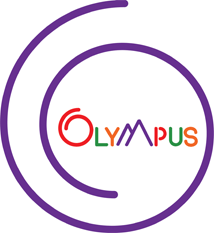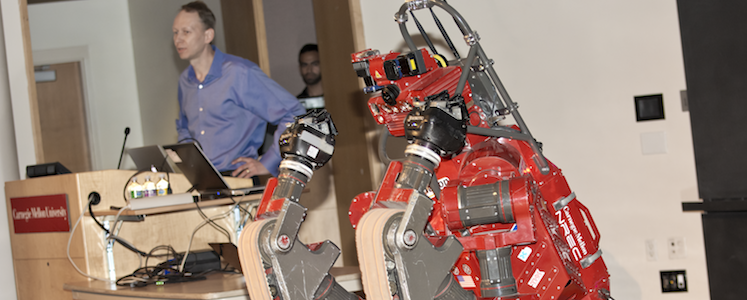Sunday, April 17, 2016
Students Discuss Innovations at Annual Project Olympus
While many Carnegie Mellon students, faculty, and Pittsburgh community members were enjoying this year’s Carnival, Project Olympus’ 20th Show and Tell captivated those in McConomy Auditorium on Thursday. Project Olympus is an annual event where students and faculty members from Carnegie Mellon present their startups and innovations to a wider entrepreneurial community. Opening the event was Provost Farnam Jahanian, who described Project Olympus as “a window into ambitious research and innovations across campus.” He explained the project’s goal as being an opportunity for students to immerse themselves in this environment so that when they leave Carnegie Mellon they will have experienced how to think with an entrepreneurial mindset and will be well equipped to deal with similar problems in the real world.
Presentations started with two Carnegie Mellon faculty members whose research is focused on the capabilities of the brain, whether it be human or mechanical. Alison Barth, professor of biological sciences at Carnegie Mellon, discussed her research on how neural circuits are wired. She relayed that a pressing dilemma for many neuroscientists is figuring out what the circuits in the brain are doing and how connections occur between them for learning to happen. She compared the brain to a bowl of spaghetti, and invited the audience to picture that bowl of spaghetti being cut in half. With this image in mind, it’s difficult to figure out what aligns with what. Barth presented slides to the audience that showed each of the brain’s synapses being assigned by type, and how this can allow us to identify how different connections respond. She hopes that her research will lead to finding a comprehensive, unbiased way to look at the brain’s synapses to determine how its circuits are changing.
Mike Vande Weghe, lead robotics engineer at the Robotics Institute, shifted the audience’s attention from the human brain to the possibilities of artificial intelligence. Weghe’s robot CHIMP definitely stole the show at this year’s show and tell. CHIMP was built for the 2012 Darpa Robotics Challenge. Weghe explained that his team wanted to create a robot that could roll in addition to walking, and could transition from being on all four’s to using its two legs, thus providing more mobility. Weghe presented a video from the competition showing CHIMP losing its balance, which was fated for all robots in the competition. He proudly expressed that while all the other robots needed human assistance to get back up that CHIMP managed to get up on its own. CHIMP managed to come in third place in the competition, which, although not first, still made Weghe happy with its performance. With this invention, Weghe stated that he wants people to know that “robots are at the point where we can do useful things with them.”
Following Barth and Weghe were six students, who each gave three minute presentations on their own startups and innovations. The diversity of the students, from all the different colleges, speaks to the potential for innovation across any field. Eleanor Haglund, a creative writing major, and Nesra Yannier, who holds an M.A. degree in Learning, Design, and Technology from Stanford University, presented two of the most interactive innovations. Haglund discussed e. e. books, an enhanced e-book software that differs from regular e-books because of its implementation of media. Haglund explains that e. e. books were created as a solution to help the low supply of enhanced e-books, which is due to their creation being time consuming and them not being able to reach a wide audience. “We’re taking the next step in the creation of enhanced e-books,” Haglund said. Yannier talked about NoRILLA, a mixed-reality educational system that seeks to “promote discussion and turn [children] into little scientists” and thus preparing them for a better future. It has been proven to increase children’s learning by five times. In a video shown to the audience, one child using NoRILLA exclaims “it was fun, I don’t want to stop playing it.”
Torrell Jackson, who is pursuing a dual Masters degree in both Business Administration and Health Care Policy & Management, spoke about Chiroproktor, a new technology that will allow its users to better understand the human body. It is a lifelike tool that allows users to practice spine repair, as one example, at their own convenience on their laptops or smart phones. Also focusing on the human body was Andy Chan, who started VIT, a company that allows its users to focus on certain behaviors that cause health problems and to identify the issue before it can incite serious health problems. VIT does this by measuring one’s fatigue index. “The more tired you are, the more your body can’t withstand stress,” Chan said. Chan hopes that VIT can help companies save time and money spent on worker injuries by preventing these injuries from even occurring.
James Laney talked about Aero Laboratories which uses automated data acquisition to increase the quality of inspection of utility companies. According to Laney, Aero Laboratories aims to take manned operations and turn them into unmanned systems. Aero Laboratories is able to take an image and “detect and classify any potential hazard,” Laney said.
The last student presentation was given by Xunjie Zhang, a first year masters student in the Robotics Institute. Zhnag presented Nimbus, motorized shoes that “will easily double your walking speed,” Zhang said. Zhang presented these wheeled shoes as being ideal for students who are late to class. He compares the invention as being like walking on an airport runway but instead creating this feeling everywhere you go. This was exemplified with a video shown by Zhang which showed him speeding past other Carnegie Mellon students around campus. Read More»

